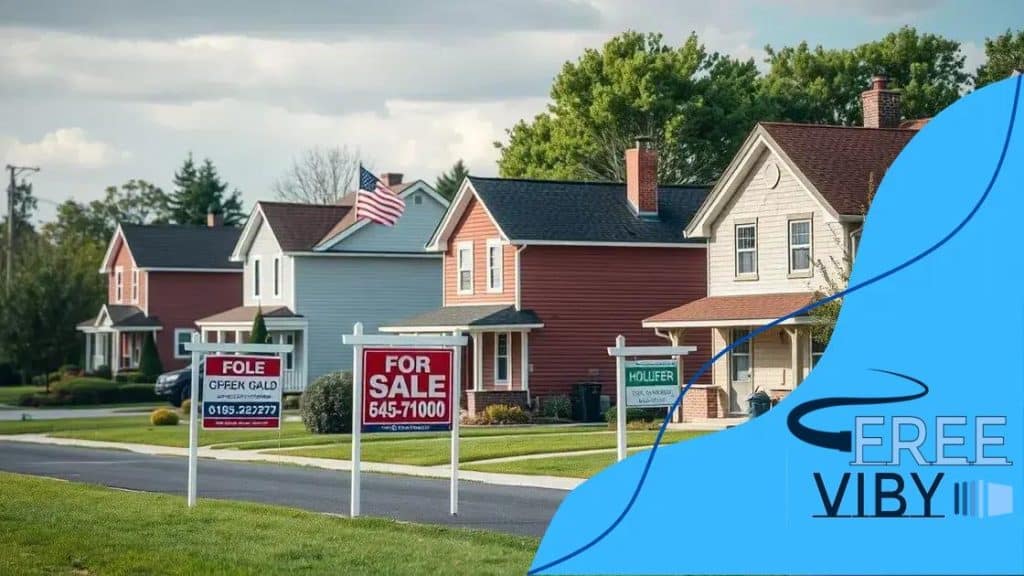US housing market slowdown: Is your dream home within reach?

Anúncios
Wondering how today’s market shifts impact your homebuying plans? The US housing market slowdown brings falling demand, higher rates, and more inventory, creating unique opportunities amid challenges.
So, let’s dive into what this cooling trend means for your real estate journey!
Anúncios
Current trends in the US housing market
The US housing market slowdown is reshaping real estate with declining sales, rising borrowing costs, and growing inventory. This shift from the pandemic’s frenzied market signals a more balanced landscape, affecting buyers, sellers, and investors alike.
Economic pressures like inflation and stricter lending standards cool buyer enthusiasm, while sellers adapt to less competitive conditions. Regional variations add complexity, with some areas facing sharper slowdowns than others.
Understanding these trends empowers stakeholders to make informed decisions. The US housing market slowdown offers buyers leverage to negotiate and sellers a chance to refine strategies for success.
Declining home sales
A hallmark of the US housing market slowdown is the drop in home sales, driven by mortgage rates above 7%, making loans costlier. Buyers hesitate, opting to delay purchases or seek smaller, affordable homes.
Anúncios
Economic uncertainty, including job and recession fears, prompts a cautious approach. Many buyers anticipate price drops, staying sidelined for better deals, reducing transaction volumes.
This shift creates a balanced market, with homes lingering longer and fewer bidding wars. The US housing market slowdown challenges sellers but opens negotiation opportunities for prepared buyers.
Increased inventory
The US housing market slowdown boosts housing inventory, giving buyers more options and less competition. This shift from a seller’s market reduces pressure, allowing time to find homes that match needs.
Sellers face slower sales and may need to adjust pricing expectations, as high listings risk prolonged market time. Strategic preparation, like staging, becomes key to attract buyers.
This buyer-friendly trend in the US housing market slowdown empowers negotiations, offering a chance to secure properties at fairer prices in a less rushed environment.
Shifting buyer preferences
Buyer priorities are evolving in the US housing market slowdown, driven by remote work and lifestyle changes. Demand grows for homes with office spaces, flexible rooms, and outdoor areas for wellness.
Younger buyers seek energy-efficient, tech-savvy homes, reflecting sustainability concerns, while older buyers downsize to low-maintenance properties. Suburban and rural areas gain appeal for affordability.
Sellers must highlight these features to stand out, while buyers can leverage the US housing market slowdown to negotiate for homes aligning with these modern preferences.
Factors contributing to the slowdown
The US housing market slowdown results from economic, social, and policy factors. Rising interest rates, spurred by Federal Reserve hikes to curb inflation, have spiked borrowing costs, deterring buyers.
Increased inventory and economic uncertainty, including job and recession concerns, reduce demand. Inflation strains budgets, limiting savings for down payments or moving costs.
Zoning laws and high construction costs restrict new supply, exacerbating affordability issues. These dynamics reshape the US housing market slowdown, demanding strategic navigation by all stakeholders.
Rising interest rates
One significant factor driving the US housing market slowdown is the steady rise in interest rates. As the Federal Reserve continues to combat inflation, borrowing costs have surged, pushing mortgage rates to levels not seen in over a decade.
When mortgage rates increase, monthly payments become significantly more expensive, often putting homeownership out of reach for many potential buyers.
This financial pressure is leading more individuals to either reduce their budgets or delay purchasing altogether in hopes of more favorable conditions.
Economic uncertainty
Economic uncertainty fuels the US housing market slowdown, with fears of recession, job instability, and market volatility dampening consumer confidence. Buyers hesitate to commit to large purchases like homes.
Inflation erodes disposable income, making it harder to save for down payments or cover moving costs. This caution reduces market momentum, cooling transaction volumes.
This climate of doubt in the US housing market slowdown pushes stakeholders to stay informed, adapting strategies to navigate an unpredictable economic landscape effectively.
Changes in housing demand
Shifting demand shapes the US housing market slowdown, as pandemic-era low rates and remote work fade. Buyers now face affordability challenges, with some returning to rentals or downsizing.
Stricter lending standards limit qualified buyers, requiring higher credit or larger down payments. Remote work still drives interest in suburban areas, but supply lags.
The US housing market slowdown reflects these evolving priorities, urging buyers and sellers to align with current trends to capitalize on market opportunities.

Impact on home prices
The US housing market slowdown is cooling home prices, moving away from pandemic-era bidding wars. Declining demand and economic pressures flatten growth, with some regions seeing slight declines.
Sellers face increased competition, requiring strategic pricing to attract buyers. Buyers gain leverage with more options, enabling savvier negotiations in a balanced market.
Long-term, prices may stabilize in strong markets or correct in overheated ones. The US housing market slowdown demands flexibility and local insight for pricing decisions.
Decreased demand
Reduced buyer demand drives the US housing market slowdown, with high rates and uncertainty pushing many to pause purchases. Some are priced out, while others await better conditions.
This drop cools price growth, with fewer bidding wars and longer listing times. Sellers lose the edge, facing pressure to adjust to attract serious offers.
Buyers benefit from this shift in the US housing market slowdown, gaining time to negotiate and secure homes at fairer prices in a less competitive market.
Competitive pricing
Sellers in the US housing market slowdown must price strategically, as high listings risk extended market time. Reviewing local sales and being open to reductions is crucial.
Buyers can negotiate reductions or concessions, leveraging less urgency. Understanding fair market value prevents overpaying, even for discounted properties.
This balanced market in the US housing market slowdown favors informed decisions, with both parties using local trends to guide pricing and negotiation strategies.
Long-term effects
The US housing market slowdown suggests long-term price stabilization, with overheated markets facing corrections. Balanced regions with job growth may see modest gains.
Economic factors like rates and confidence will shape trends. Buyers should monitor these, while sellers set realistic expectations for future value.
Navigating the US housing market slowdown requires patience and local insight, aligning strategies with emerging price dynamics for successful outcomes.
Advice for potential buyers
The US housing market slowdown offers buyers opportunities but requires strategy. Less competition and more inventory create leverage, yet high rates demand careful financial planning.
Preparation — pre-approval, clear priorities, and local trend awareness — positions buyers to act decisively. Balancing caution with action maximizes opportunities in this slower market.
Buyers should leverage the US housing market slowdown to negotiate favorable terms, avoiding delays that could miss prime properties while staying financially prudent.
Be prepared to act quickly
Despite the US housing market slowdown, well-priced homes in desirable areas attract quick interest. Pre-approval and clear priorities enable confident, swift offers.
Monitoring local trends identifies markets with deeper slowdowns, offering negotiation room. Acting decisively on attractive properties prevents missing competitive opportunities.
The US housing market slowdown rewards readiness, empowering prepared buyers to secure homes that align with their goals and budget efficiently.
Research the market
Buyers in the US housing market slowdown should research neighborhoods and prices to ensure fair offers. Comparing recent sales and local trends informs competitive bids.
Online tools, open houses, and agent insights reveal market dynamics, highlighting areas with more inventory or negotiation potential.
Negotiation is key in the US housing market slowdown. Building rapport through agents can secure better terms, capitalizing on sellers’ need to compete.
Consider future needs
In the US housing market slowdown, buyers should weigh long-term needs — family growth, work changes, or lifestyle shifts — to choose homes with lasting suitability.
Flexibility in location or home style can uncover value in less competitive markets. Patience ensures the right fit without rushed decisions.
The US housing market slowdown offers time to align purchases with future goals, empowering buyers to invest wisely in homes that evolve with them.
Financing options during a slowdown
Financing is pivotal in the US housing market slowdown, with rising rates and stricter standards shaping buyer choices. Exploring loan options secures competitive terms in a tough market.
Conventional loans suit strong borrowers, while FHA, USDA, and VA loans cater to diverse needs. Special programs may emerge, aiding buyers in this slower market.
Buyers should compare rates and terms, leveraging the US housing market slowdown to find financing that aligns with their financial and homeownership goals.
Conventional loans
Conventional loans are a staple in the US housing market slowdown, offering flexibility for buyers with solid credit and 20% down payments, avoiding PMI costs.
Some lenders provide modified terms, like lower down payments, to attract buyers amid slower sales. These loans suit financially stable purchasers.
Navigating the US housing market slowdown with conventional loans demands strong credit but offers long-term savings for qualified buyers with preparation.
FHA loans
FHA loans ease access in the US housing market slowdown, requiring just 3.5% down and lenient credit standards, ideal for first-time or budget-conscious buyers.
Loan limits vary by area, so local research is key. These government-backed loans expand homeownership opportunities in a challenging market.
The US housing market slowdown makes FHA loans a valuable tool, enabling buyers with limited resources to secure affordable financing and homes.
VA Loans
VA loans shine in the US housing market slowdown for veterans and active-duty members, offering no down payment or PMI, reducing costs significantly.
Competitive rates and flexible credit requirements enhance accessibility, making these loans a cost-effective choice for eligible buyers.
Veterans can leverage VA loans in the US housing market slowdown to secure homes with favorable terms, aligning with their financial needs.
Future predictions for the housing market
The US housing market slowdown prompts forecasts shaped by rates, jobs, and buyer behavior. Understanding these trends helps stakeholders plan strategically for future decisions.
A gradual recovery is likely, with modest price stabilization or corrections in overheated markets. Economic factors will dictate the pace of change.
Staying informed on these predictions equips buyers and sellers to navigate the US housing market slowdown, seizing opportunities in an evolving landscape.
Slow recovery ahead
Experts predict a cautious recovery in the US housing market slowdown, with high rates and uncertainty slowing activity. Price growth will stay modest, avoiding past surges.
Balanced markets with strong economies may see steady demand, while others face corrections. Flexibility is key in this uneven recovery phase.
The US housing market slowdown underscores strategic timing, as economic and policy shifts shape the market’s gradual return to stability.
Continued demand for affordable housing
The US housing market slowdown fuels demand for affordable homes, prompting builders to focus on smaller, budget-friendly designs to meet buyer needs.
Sustainable, tech-driven homes gain traction, while remote work boosts suburban and rural markets with lower costs and better quality of life.
This affordability focus in the US housing market slowdown creates opportunities for buyers seeking value and sellers targeting these preferences.
Market adaptation to economic factors
The US housing market slowdown requires adaptation to inflation, employment, and rates. Strong job growth could spur demand, while high rates may delay recovery.
Buyers and sellers must monitor economic trends to time decisions, with local nuances influencing outcomes in this evolving market.
Aligning strategies with these shifts in the US housing market slowdown enables stakeholders to capitalize on opportunities and prepare for future changes.
FAQ – Frequently Asked Questions about the US Housing Market Slowdown
What factors are causing the slowdown in the housing market?
Factors such as rising interest rates, economic uncertainty, and decreased buyer demand are contributing to the slowdown in the housing market.
How can I take advantage of financing options during this slowdown?
Buyers can explore options like FHA loans, VA loans, and USDA loans to find more affordable financing methods that suit their needs.
Is it a good time to buy a home now?
It can be a good time to buy as there may be less competition and more homes available, allowing buyers to negotiate better deals.
What should I look for when researching housing trends?
Focus on local market data, price trends, and the availability of housing types that meet your needs—these factors can guide your buying decisions.






